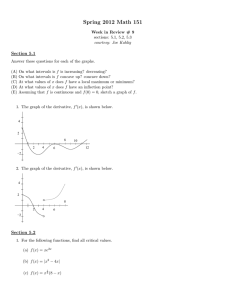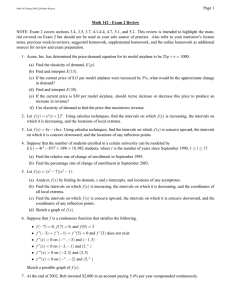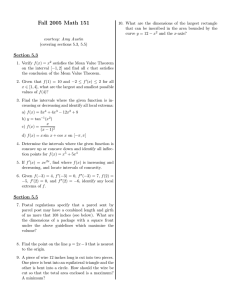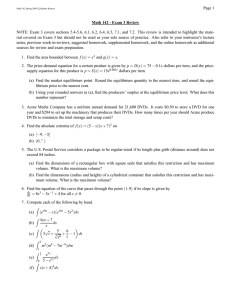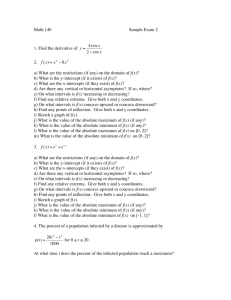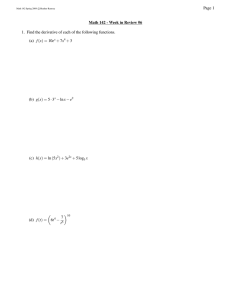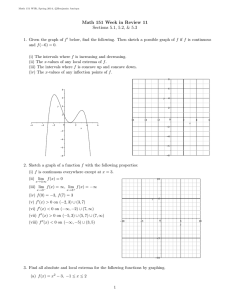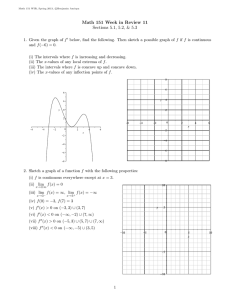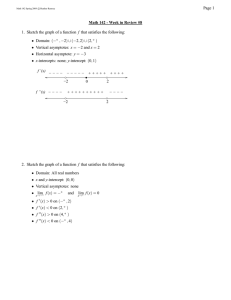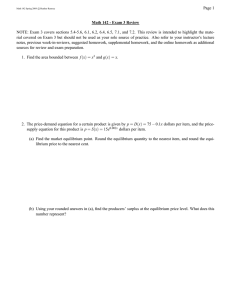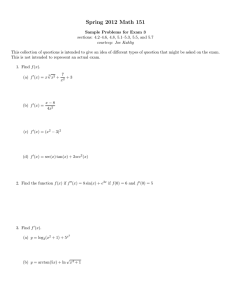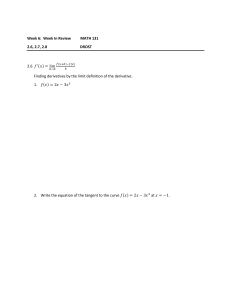Document 10503015
advertisement
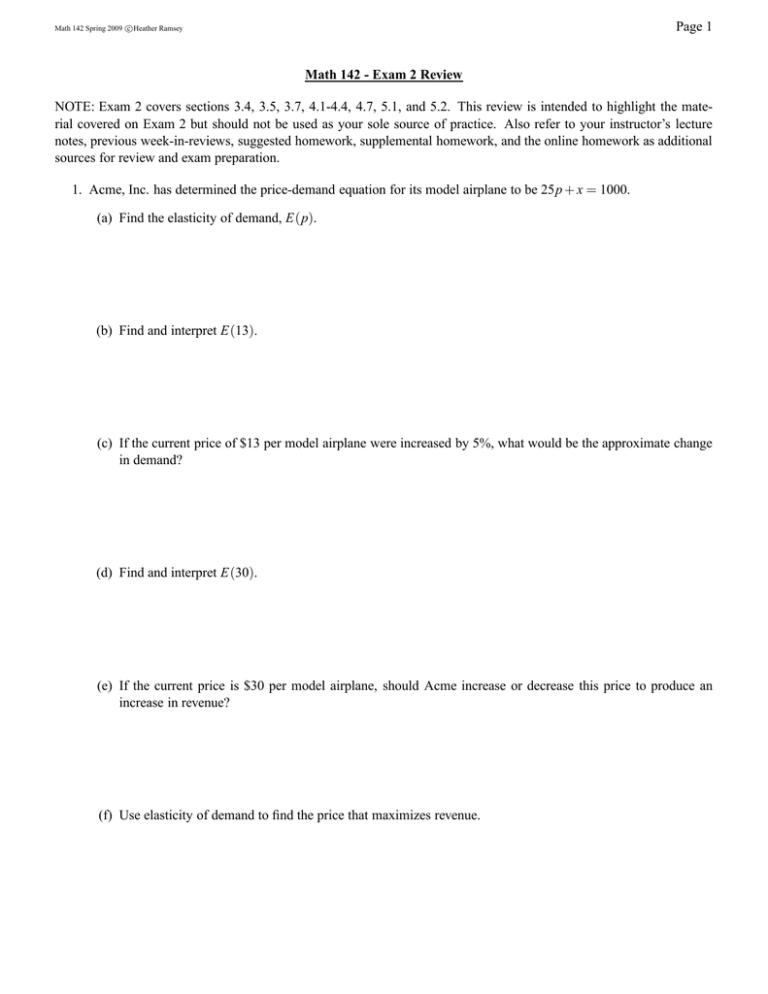
Page 1 c Math 142 Spring 2009 Heather Ramsey Math 142 - Exam 2 Review NOTE: Exam 2 covers sections 3.4, 3.5, 3.7, 4.1-4.4, 4.7, 5.1, and 5.2. This review is intended to highlight the material covered on Exam 2 but should not be used as your sole source of practice. Also refer to your instructor’s lecture notes, previous week-in-reviews, suggested homework, supplemental homework, and the online homework as additional sources for review and exam preparation. 1. Acme, Inc. has determined the price-demand equation for its model airplane to be 25p + x = 1000. (a) Find the elasticity of demand, E(p). (b) Find and interpret E(13). (c) If the current price of $13 per model airplane were increased by 5%, what would be the approximate change in demand? (d) Find and interpret E(30). (e) If the current price is $30 per model airplane, should Acme increase or decrease this price to produce an increase in revenue? (f) Use elasticity of demand to find the price that maximizes revenue. c Math 142 Spring 2009 Heather Ramsey Page 2 2. Let f (x) = ex (x + 2)2 . Using calculus techniques, find the intervals on which f (x) is increasing, the intervals on which it is decreasing, and the locations of local extrema. 3. Let f (x) = 4x − x ln x. Using calculus techniques, find the intervals on which f (x) is concave upward, the intervals on which it is concave downward, and the locations of any inflection points. 4. Suppose that the number of students enrolled in a certain university can be modeled by E(t) = 4t 3 − 87t 2 + 189t + 18, 982 students, where t is the number of years since September 1990, 1 ≤ t ≤ 17. (a) Find the relative rate of change of enrollment in September 1995. (b) Find the percentage rate of change of enrollment in September 2003. c Math 142 Spring 2009 Heather Ramsey Page 3 5. Let f (x) = (x2 − 7)(x2 − 1). (a) Analyze f (x) by finding its domain, x and y-intercepts, and locations of any asymptotes. (b) Find the intervals on which f (x) is increasing, the intervals on which it is decreasing, and the coordinates of all local extrema. (c) Find the intervals on which f (x) is concave upward, the intervals on which it is concave downward, and the coordinates of any inflection points. (d) Sketch a graph of f (x). Page 4 c Math 142 Spring 2009 Heather Ramsey 6. Suppose that f is a continuous function that satisfies the following. • f (−7) = 0, f (7) = 0, and f (0) = 3 • f ′ (−3) = f ′ (−1) = f ′ (5) = 0 and f ′ (3) does not exist • f ′ (x) > 0 on (−∞, −3) and (−1, 3) • f ′ (x) < 0 on (−3, −1) and (3, ∞) • f ′′ (x) > 0 on (−2, 3) and (3, 5) • f ′′ (x) < 0 on (−∞, −2) and (5, ∞) Sketch a possible graph of f (x). 7. At the end of 2002, Bob invested $2,000 in an account paying 5.4% per year compounded continuously. (a) Find the average rate of change of the account’s value from the end of 2005 to the end of 2008. (b) How quickly is the account’s value growing at the end of 2007? 8. Find the first derivative of g(x) = 4x ex + 3 . Page 5 c Math 142 Spring 2009 Heather Ramsey 9. Use the limit definition to find the instantaneous rate of change of f (x) = 3 − 4x2 at x = 5. 10. Find the derivative of each of the following. 2 (a) h(x) = 7 · 3ln 7x (b) j(x) = log8 3x x−9 c Math 142 Spring 2009 Heather Ramsey Page 6 11. Acme Pool Supplies has determined the price-demand function for a 50 lb bucket of its chlorine tabs to be 35x + 100p = 17, 500, where x is the number of buckets that can be sold at a unit price of p dollars. (a) Approximate the revenue earned from the sale of the 31st bucket of chlorine tabs. (b) Find the revenue and marginal revenue from the sale of 55 buckets of chlorine tabs. (c) Use your answers in (b) to approximate the revenue earned from the sale of 58 buckets of chlorine tabs. (d) Acme Pool Supplies has a fixed cost of $7,400 and a production cost of $34 per bucket. Find a model for average cost. (e) Find the marginal average profit of producing and selling 42 buckets of chlorine tabs. c Math 142 Spring 2009 Heather Ramsey Page 7 12. The following graph represents the first derivative of a function f . Approximate your answers to one decimal place. (a) Where is f (x) increasing? Decreasing? (b) Where does f (x) have local extrema? (c) Where is f (x) concave up? Concave down? (d) Where does f (x) have inflection points? 13. Find the derivative of f (x) = (4x − 3)7 ln (2x − 7). Page 8 c Math 142 Spring 2009 Heather Ramsey 14. Find the derivative of g(x) = 5x 4x − 6 3 . 15. A rational function f , which has domain (−∞, −2) ∪ (−2, 2) ∪ (2, ∞), has first derivative f ′ (x) = 16x (x2 − 4)2 (a) Find the intervals where f is increasing and decreasing. Identify any local extrema. (b) Find f ′′ (x) and simplify. (c) Find the intervals where f is concave upward and concave downward. Identify any inflection points. .
